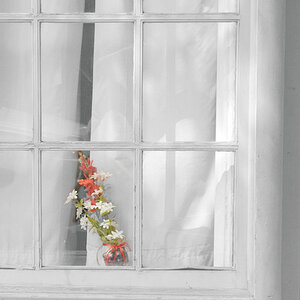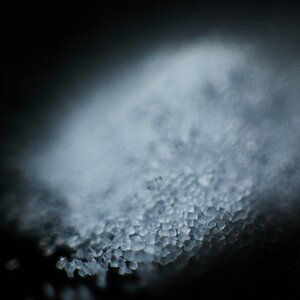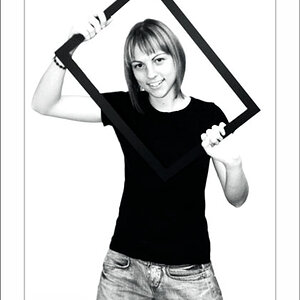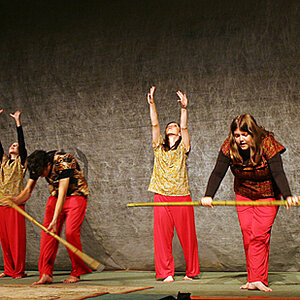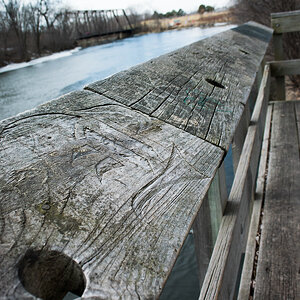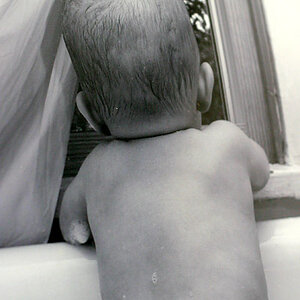Navigation
Install the app
How to install the app on iOS
Follow along with the video below to see how to install our site as a web app on your home screen.

Note: This feature currently requires accessing the site using the built-in Safari browser.
More options
You are using an out of date browser. It may not display this or other websites correctly.
You should upgrade or use an alternative browser.
You should upgrade or use an alternative browser.
Is it right or wrong to use both UV and Polarizer filters together?
- Thread starter Macno
- Start date
- Joined
- May 1, 2008
- Messages
- 25,418
- Reaction score
- 4,999
- Location
- UK - England
- Website
- www.deviantart.com
- Can others edit my Photos
- Photos OK to edit
It depends on the situation.
First up reason out if you need to have both on the lens at the same time - are they doing something for you or are they just sitting on the lens because they can. A UV filter on modern DSLRs and films isn't doing very much in most situations since DSLRs are already filtering out UV light as part of their sensor construction. At high altitudes and in certain high haze conditions the UV filter does help filter out the haze from UV light - but in general shooting its only sitting there as a light protection infront of your main lens.
If you do have a situation where you mount both understand that:
1) You're adding more glass to the setup, thus incurring a degradation to your overall optical quality. With highgrade filters on a good lens this is marginal to unnoticeable in most situations. Lower grade filters will of course result in a much more noticable image quality drop
2) Increased chances of lens flaring - again more glass more chance
3) Increased chance of vignetting (corner darkness). On crop sensor this is typically not a big problem unless using ultra wide angle lenses - on fullframe it can show up much earlier.
First up reason out if you need to have both on the lens at the same time - are they doing something for you or are they just sitting on the lens because they can. A UV filter on modern DSLRs and films isn't doing very much in most situations since DSLRs are already filtering out UV light as part of their sensor construction. At high altitudes and in certain high haze conditions the UV filter does help filter out the haze from UV light - but in general shooting its only sitting there as a light protection infront of your main lens.
If you do have a situation where you mount both understand that:
1) You're adding more glass to the setup, thus incurring a degradation to your overall optical quality. With highgrade filters on a good lens this is marginal to unnoticeable in most situations. Lower grade filters will of course result in a much more noticable image quality drop
2) Increased chances of lens flaring - again more glass more chance
3) Increased chance of vignetting (corner darkness). On crop sensor this is typically not a big problem unless using ultra wide angle lenses - on fullframe it can show up much earlier.
Propsguy
No longer a newbie, moving up!
- Joined
- Mar 20, 2011
- Messages
- 176
- Reaction score
- 31
- Location
- ontario, canada
- Can others edit my Photos
- Photos OK to edit
I usually leave the uv filter on and thread the polarizer onto the uv filter.... a lot of people may say that stacking filters has the potential to degrade the image, and in some cases this is true, but most (high quality) uv filters are pretty transparent to the image quality, and keeping the uv filter won't hurt anything...
For my circular polarizers, I always stack onto a uv filter because it gets so jammed onto my lens that I fear I'll never get the thing off, so it's easier to take both off at the same time and fight to get the pola off the uv... but I guess that's a different discussion...
anyways... if you stack, put the polarizer in front....
For my circular polarizers, I always stack onto a uv filter because it gets so jammed onto my lens that I fear I'll never get the thing off, so it's easier to take both off at the same time and fight to get the pola off the uv... but I guess that's a different discussion...
anyways... if you stack, put the polarizer in front....
Gaerek
No longer a newbie, moving up!
- Joined
- May 2, 2009
- Messages
- 1,341
- Reaction score
- 98
- Location
- Tucson, AZ
- Can others edit my Photos
- Photos NOT OK to edit
I usually leave the uv filter on and thread the polarizer onto the uv filter.... a lot of people may say that stacking filters has the potential to degrade the image, and in some cases this is true, but most (high quality) uv filters are pretty transparent to the image quality, and keeping the uv filter won't hurt anything...
For my circular polarizers, I always stack onto a uv filter because it gets so jammed onto my lens that I fear I'll never get the thing off, so it's easier to take both off at the same time and fight to get the pola off the uv... but I guess that's a different discussion...
anyways... if you stack, put the polarizer in front....
It's not just a chance to degrade the image. Honestly, going off of image quality alone, you'd be hard pressed to find a difference, unless you were using incredibly cheap filters. The real problem comes from increased chance for lens flare and increased chance of vignetting. Most lenses are designed, through the use of coatings and simply build design to reduce lens flare to a minimum. Adding another air pocket in front of the lens with glass the lens maker wasn't intending will dramatically increase the chance for flare. Add a second air pocket, from the second filter and you're just compounding the problem. Vignetting is a problem, but if you're not shooting wide, it likely won't even be an issue. However, the more stuff you stack in front of that front element, and the wider you go, the bigger the problem gets, so it is something to concern yourself.
The real question, from the OP, shouldn't be can he do it. It should be, why would he do it. If you're using the UV as a "lens protector" then won't the CPL do the same job without the UV? I won't debate on the merits of using a UV filter to protect a lens or not (though I'll give my opinion, it's not really needed, especially if you're using a lens hood), but beyond use as a lens protector, UV filters are pretty much useless in the digital world. So those are things to consider. Whether you use a UV or not, it's usually not recommended to stack filters on top of each other. Use the minimum you need for the job at hand.
analog.universe
TPF Noob!
- Joined
- Apr 16, 2011
- Messages
- 1,923
- Reaction score
- 330
- Location
- Vermont
- Can others edit my Photos
- Photos OK to edit
I only stack if the atmospheric conditions make me terrified of taking the UV off. (blowing sand, etc...) So like, <1% of the time. Otherwise having 2 flat, parallel pieces of glass in front of the lens is just asking for flare.
Bitter Jeweler
Been spending a lot of time on here!
- Joined
- Apr 27, 2009
- Messages
- 12,983
- Reaction score
- 4,991
- Location
- Cleveland, Ohio
- Can others edit my Photos
- Photos OK to edit
Don't image sensors already have UV filtering on them?
joealcantar
TPF Noob!
- Joined
- Apr 23, 2011
- Messages
- 840
- Reaction score
- 85
- Location
- Beaumont, CA
- Can others edit my Photos
- Photos OK to edit
-Don't image sensors already have UV filtering on them?
More than likely they do, but I would not make a comment like that in a newbie section as they kind of listen to what the veterans say.
If conditions are right and you have all control for the most part it is fine to leave it off if you feel it is affecting the quality of the image.
Myself , I would not stack them if I thought the shot was going to be a keeper.
-
Shoot well, Joe
Last edited:
analog.universe
TPF Noob!
- Joined
- Apr 16, 2011
- Messages
- 1,923
- Reaction score
- 330
- Location
- Vermont
- Can others edit my Photos
- Photos OK to edit
I have UV filters because the clear glass is barely cheaper. It's nice to never have to touch the actual lens with cleaning supplies. I can get my filter messy, and then clean it off, and not worry about destroying a huge investment in the process. The impact protection thing I'm not sure if I believe, just don't be a klutz  But for all the stuff that lands on my filter and gets wiped off, I'm really glad it's not on the lens instead.
But for all the stuff that lands on my filter and gets wiped off, I'm really glad it's not on the lens instead.
- Joined
- May 1, 2008
- Messages
- 25,418
- Reaction score
- 4,999
- Location
- UK - England
- Website
- www.deviantart.com
- Can others edit my Photos
- Photos OK to edit
-Don't image sensors already have UV filtering on them?
Don't give out bad advice, some of these folks are new , If one does not invest in a decent protective filter to protect the lens it is like driving around without car insurance. You are taking a gamble.
-
Shoot well, Joe
Um Image sensors do have UV filters on them and I think even modern lenses filter out UV light as best they can with coatings. As said above outside of very high haze and high altitude work the UV filter is not blocking out UV light so much as acting as a protection.
However one has to understand that filters are thin glass - its protection against dust, sand, water, and other similar light debries. It lets you quick wipe the front of your lens clean when shooting without having to worry about scratching your front element (though good filters are still not dirtcheap to replace). However against heavier impacts its all but pointless and can act as a negative since not only will it shatter, but all that glass will cut back against your front element.
So it won't protect from a stone and in a fall it will shatter and most likely get stuck on your lens - but it will protect against sticky fingers, sand, mud, water, oils etc..
- Joined
- Apr 9, 2009
- Messages
- 41,401
- Reaction score
- 5,706
- Location
- Iowa
- Website
- kharrodphotography.blogspot.com
- Can others edit my Photos
- Photos OK to edit
That is utter nonsense, because you are also taking a gamble WITH a UV filter on the lens. The safest approach is be be aware of what you are doing (situational awareness) and use good camera and gear handeling procedures.-Don't image sensors already have UV filtering on them?
Don't give out bad advice, some of these folks are new , If one does not invest in a decent protective filter to protect the lens it is like driving around without car insurance. You are taking a gamble.
-
Shoot well, Joe
No doubt, there are limited situations where using a UV or clear filter for protection are called for, but the vast majority of shooters won't need any lens 'protection'.
The glass in a UV filter is a lot thinner than the front lens element. The front lens element is also likely backed internally by additional lens elements use to control various lens aberrations. Consequently, it is not all that easy to break a front lens element, but it is pretty easy to break a thin UV filter.
There are 3 main ways a UV filter can be broken:
- drop the camera/lens
- drop just the lens
- something impacts the front of the UV filter while the lens is mounted on the camera.
Don't give out bad advice. Any filter added to the front of a lens, including high quality filters, promotes lens flare and the associated loss of contrast. Use of the lens hood offers a large degree of protection to the front lens element from impact damage.
I have never used a filter, of any kind, for 'protection', nor have I ever damaged a front lens element by impact or by cleaning.
YouTube - ‪Canon Glass‬‏
LensRentals.com - Front Element Scratches
Last edited:
Pgeobc
TPF Noob!
- Joined
- Sep 24, 2009
- Messages
- 146
- Reaction score
- 1
- Location
- Indian Territory
- Can others edit my Photos
- Photos NOT OK to edit
Well, nobody else mentioned it, so I will: Using both is neither wrong nor right. It is, however, unnecessary. Since polarizers alread cut more UV than the typical UV filter, adding the usual UV-A filter would be redundant and, therefore, without purpose.
GooniesNeverSayDie11
No longer a newbie, moving up!
- Joined
- Oct 7, 2010
- Messages
- 1,684
- Reaction score
- 203
- Location
- The Goondocks
- Can others edit my Photos
- Photos NOT OK to edit
-Don't image sensors already have UV filtering on them?
Don't give out bad advice, some of these folks are new , If one does not invest in a decent protective filter to protect the lens it is like driving around without car insurance. You are taking a gamble.
-
Shoot well, Joe
I drive around with Camera insurance. It costs me about $16 a month for professional use coverage. It has a $100 deductable and covers my 10.5K worth of gear. I can drop my entire bag off of a cliff at the grand canyon, go home and pay my $100 deductable and get all brand new gear ( including a 70-200 MKII since they no longer make the MKI which I have ). I figure for $16 a month, thats less than what I would pay for 2 high quality UV filters per year. And if its as dangerous as you say, that means those UV filters would be often scratched and often need replacing. So I would end up spending more for LESS safety in the long run. Right?
To the OP, lose the UV filter, stick with the polarizer. As people said, its redundant and utterly useless.
Most reactions
-
 459
459 -
 288
288 -
 276
276 -
 261
261 -
 210
210 -
 196
196 -
 190
190 -
 186
186 -
 180
180 -
 173
173 -
 149
149 -
 134
134 -
 119
119 -
I
109
-
 90
90
Similar threads
- Replies
- 20
- Views
- 493
- Replies
- 3
- Views
- 78

![[No title]](/data/xfmg/thumbnail/30/30861-fee88082ba36d0c3b443492fe3f3f1cd.jpg?1619734481)
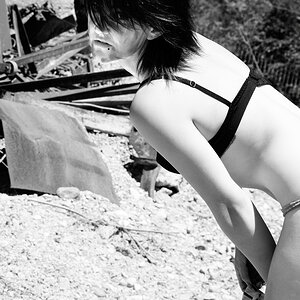
![[No title]](/data/xfmg/thumbnail/39/39439-d0a6beaaf39993860b74ccbd81fdd122.jpg?1619739032)
